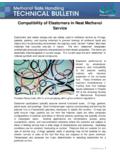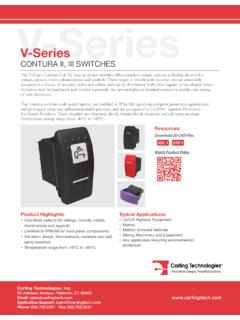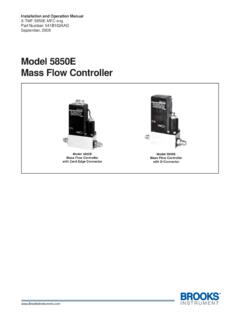Transcription of INSTALLATION PROCEDURE Detroit Diesel DD15/DD13
1 1 Evans Cooling Systems, Inc. 255 Gay Street Sharon, CT 06069 INSTALLATION PROCEDURE Detroit Diesel DD15/DD13 PROCEDURE for installing Evans Waterless Heavy Duty Coolant and a ResistorPac into a Detroit Diesel dd15 or DD13 engine VER 22 Oct2012 CAUTIONARY NOTE: DO NOT FLUSH COOLING SYSTEM WITH WATER! The conversion does not include a thermostat change. dd15 s and DD13 s have an inlet-side thermostat. The thermostat controls the temperature of the coolant at the inlet to the engine, rather than at the outlet from the engine. In this situation, Evans waterless HD coolant gets hotter passing through the engine than water-based coolant does, obviating the need to use higher temperature thermostats.
2 The ResistorPac raises the fan-on, fan-off, and derating temperatures by making the ECM think the temperatures are cooler than they really are. The ECM-driven Coolant temperature gauge will reflect what the ECM thinks the temperature is. 1. Obtain from Evans Cooling Systems (888-990-2665) or an Evans dealer: a. 16 gallons of Evans Waterless Heavy Duty Coolant will fill the engine and provide 1 gal for flushing and 1 spare gallon. Additional coolant will be needed if there are additional circuits requiring coolant. b. Labels to warn against the addition of water c. ResistorPac RP7-C10-DD2-2125 d. Special refractometer for measuring small pct water content Evans Part No.
3 E2190 e. An Evans Water-Chaser P/N E2195, a device useful for inserting coolant into hoses for flushing f. Evans P/N E2195H Flex Extension for Makita blower (see below) 2. Obtain from Freightliner a new coolant filter element. 3. Important items: a. A high-volume air source (rather than high pressure) such as Makita blower Model UB 1101, widely available from the internet (not from Evans). b. You may encounter a hose with an elastomer clamp. Use a torch to heat a screwdriver and then drag the hot screwdriver along the elastomer to melt it. On re-assembly, if you don t have a replacement elastomer hose clamp, use a conventional hose clamp. c. A small funnel and a large funnel.
4 4. Important: The engine must be cool to efficiently remove the water-based coolant because the plug for draining the block is in a confined location that can burn your hand. 5. Place containers to catch coolant at draining locations. 6. Remove the pressure cap. 2 7. Drain the radiator, leaving it to drain. 8. Drain the block. The plug has a 19 mm hex head and is located behind and just forward of the thermostat housing and can be reached from the lower left corner of the engine. The thermostat is an inlet type and its housing connects to the lower radiator hose. Leave the plug out until instructed otherwise. The red arrow points to the drain plug 9.
5 About the heater lines: The source is from the cylinder head and the return goes to the thermostat housing. A manifold at the top of the engine at the RH rear connects to the return lines and sends a single return hose to the thermostat housing. The square block is the collection manifold 10. Draining the heater circuits (use the Water-Chaser for these operations): a. Disconnect the heater hoses from the cylinder head end. (If the clamps are of the heat-shrink type, cut them with a red-hot screw driver. Later, replace with ordinary clamp.). b. Turn the cab heater on and set to max temperature. c. If there is a second heater ( for a sleeper cab), turn it on and set it to max.
6 D. Turn the key on . e. Using the Water Chaser, blow air through the source hose(s) until there is no further flow out the block drain. 3 f. Insert a quantity of Evans waterless HD coolant into the Water Chaser and blow it through the source heater hose(s) until there is no further flow out the block drain. g. Reattach the hose end(s). Replace heat shrink clamps with conventional clamps, if applicable. 11. If there is a transmission cooler and a coolant hose source connection from the engine, open the hose and, using the Water Chaser, blow air toward the transmission cooler. Insert a quantity of Evans waterless HD coolant into the Water Chaser and blow more air.
7 Re-connect the hose. 12. In a like manner, blow out any coolant residing in devices such as APUs or DEF tank heaters and chase with Evans waterless HD coolant. Vent line from top of the EGR cooler 13. Remove the vent line from the top of the EGR cooler. Using the Water Chaser, blow air into the engine through the EGR vent until no coolant comes out of the block drain. Re-attach the vent line. 14. Blow air into the expansion tank until no fluid comes out of the block drain. 15. Open the coolant filter canister and withdraw the element. Remove all old coolant that remains in the canister. Install the new coolant filter element and close the cover.
8 Top radiator hose connection and location of the coolant temperature sensor 16. Disconnect the top radiator hose. Blow air into the radiator until no fluid comes out of the radiator drain. Then blow air into the engine until no coolant comes out of the block drain. Pour new coolant or Prep Fluid into the outlet housing and chase with more air until no fluid comes out of the block drain. Re-connect the top radiator hose. 4 Coolant Temperature Sensor Connector Details Assembled connector To open the connection Press down on the grey tab First pull the grey tab outward and pull the connection apart Connector Disassembled To connect: 1) Insert until clicked 2) Slide tab inward until clicked 17.
9 Un-plug the connector at the coolant temperature sensor, making two connection points. Install the ResistorPac by plugging its connectors into the two connection points. Use zip-ties to neaten the wires. The coolant temperature sensor is at the RH front of the engine, at the engine coolant outlet to the top of the radiator. 18. Close the radiator drain and install the block drain plug. 19. Police the hose connections to assure that they are tight. 20. Re-install any ducting removed to provide access. 21. Fill the cooling system with Evans waterless Heavy Duty Coolant. 22. Operate the engine to assure the opening of the thermostats and thorough circulation of the coolant.
10 Add coolant as required to maintain the hot level. 23. Place the labels to warn against the addition of water or water-based coolant. 24. If the above PROCEDURE has been rigorously followed, the water content of the coolant should be within specification (below 3 percent). To verify that the coolant contains less than 3% water, take a refractometer reading after several days of operation to assure that the thermostats have opened and that the coolant is thoroughly mixed in the system. 25. Verify that the water content of the installed coolant is three percent or less. Please see the last page of this PROCEDURE for use of the Evans refractometer. 26.








